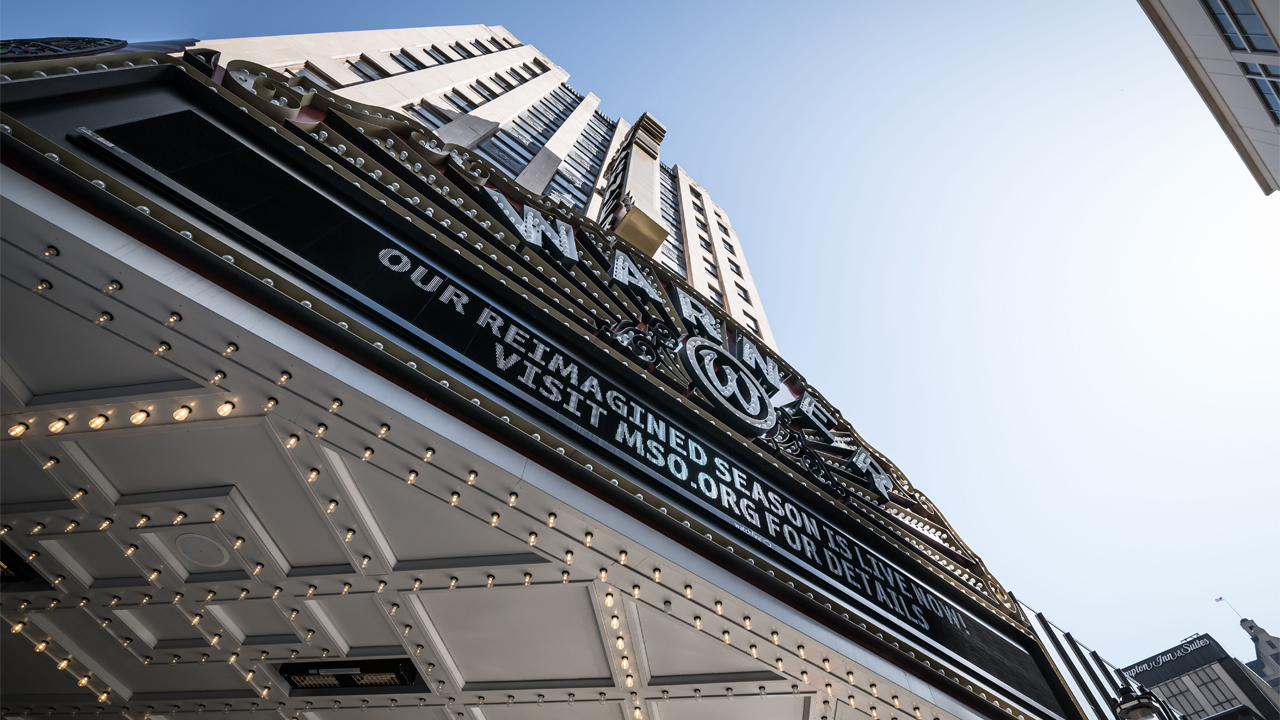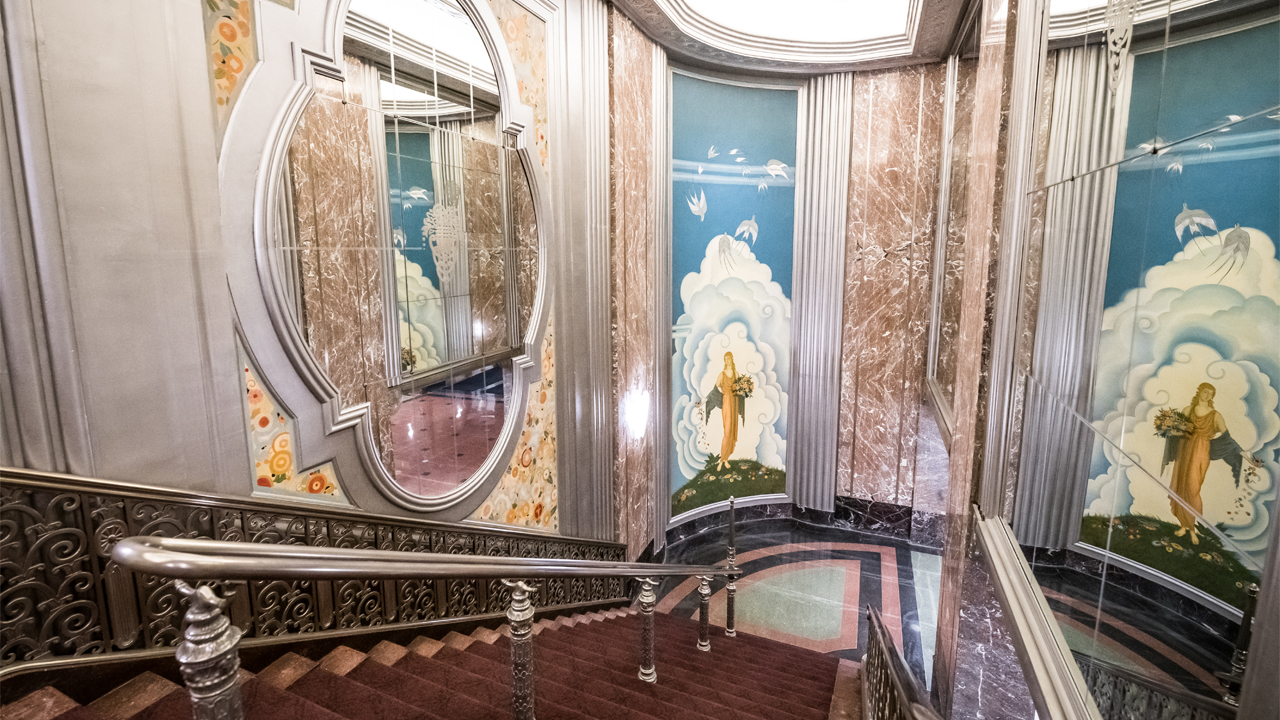The Warner Grand Theatre in downtown Milwaukee opened on a spring evening 90 years ago in an opulent display that seemed to defy the economic devastation of the Great Depression.
The architectural spectacle – replete with a marquee sign illuminated by 12,000 bulbs, a 2,500-seat theater and walls covered in Louis XIV-inspired murals – was celebrated with plenty of fanfare, including mayoral and gubernatorial addresses before the showing of the 1931 musical comedy “Sit Tight.”
As it happens, the theater this spring is making its second debut during another national crisis that has rendered its opening more understated than the first. For the past 33 months, the building at 212 W. Wisconsin Ave. has undergone a transformation to become the Milwaukee Symphony Orchestra’s new home. One of the more ambitious revitalizations of a cultural asset in the city, the $89 million project has restored a historic landmark that longtime Milwaukee residents have likely not stepped foot in since the building closed in 1995 and newer residents might be surprised to know exists.
The conversion of the Warner Grand into a symphony concert hall involved restoring the 1930s movie theater, lobby and concourses and constructing a new, two-story addition east of the theater. Beyond returning the facility to its original splendor, the project involved complex challenges like moving back the theater’s 650-ton rear wall by 35 feet into Second Street to make room for a larger stage. (Read more about the construction project here.)
The new symphony center was originally intended to welcome audience members in a grand opening scheduled for fall 2020, but, as with most celebrations over the past year, COVID-19 disrupted those plans. MSO was forced to make its 2020-‘21 season virtual due to city gathering limits, and in another setback, significant flooding caused by a storm last spring delayed construction progress.
Earlier this month, the venue hosted its first ticketed live performance for a limited-capacity show available to a select group of ticketholders – a model that MSO will continue through the remainder of the season. While performing for small groups of socially-distant subscribers doesn’t lend itself to the collective “wow” factor of a packed-out theater, MSO executive director Mark Niehaus sees it as an opportunity to have small celebrations every week for a few months, like a “birthday party every Saturday.”
“It’s kind of like being in slow motion,” he said. “Had we not had the pandemic, we likely would have popped all the corks this past September and done everything all at once. In this case, we have our first rehearsal, then our first concert that’s broadcast, then we have recorded concerts and live broadcast – every milestone is separate instead of at the same time. It’s almost like a slow rollout of everything we do. It’s very different than what would have been.”
Those incremental openings will ultimately lead up to what MSO leaders hope will be a more traditional grand opening in the fall.
The right timing
The crescendo to the new Bradley Symphony Center’s opening has been building for more than two decades.
MSO, which had long performed at the Marcus Performing Arts Center, has wanted its own dedicated space for years, saying it is key to ensuring the organization’s long-term viability. Owning its own building means having control over performance schedules, seeking out other revenue generators, and – a more recent concern – having complete oversight related to health and safety measures throughout the building.
MSO had its eye on the Warner Grand as far back as 2000. That year, the MSO conducted an acoustical test in the then-shuttered movie theater. It passed the test.
“Immediately we knew it was a special place,” Niehaus said.
The timing wasn’t right to move forward, though. Expanding the building toward North Second Street was a nonstarter – it was a high-traffic artery to the freeway before the Marquette Interchange was rebuilt.
There were also concerns about the future of the Marcus Center if the orchestra were to leave. Since then, the Marcus Center has added Broadway shows to its lineup, which have offered a new source of revenue for that venue but created logistical challenges for MSO in the winter months.
“I would joke that if there were 465 days in a year and two Decembers, the Marcus Center would be great, but that’s not the reality,” Niehaus said.
There were also concerns about whether the philanthropic community could sustain another big campaign on the heels of the heavy lift to fund the Milwaukee Art Museum’s Quadracci Pavilion and Calatrava addition. The appetite for another large cultural project wasn’t there at the time, Niehaus said.
Not to mention the massive architectural and construction challenges that it would take to preserve the theater’s original elements while adding 21st Century amenities that audiences want.
When Susan Martin joined the MSO board in 2015 and she had her first tour of the then-shuttered theater, she admits she was slow to catch the same vision that Niehaus and former board chairs Doug Hagerman and Andy Nunemaker had for the space.
“The first time I walked into it as an abandoned old building, I remember thinking, ‘this really seems like a crazy stretch,’” Martin, now MSO’s board chair, said.
The project picked up steam in December 2016, when MSO announced an anonymous donor was leading the then $120 million initiative for the organization to buy and renovate the theater, build MSO’s endowment, pay off pension liability and bolster its operating fund. That total has since swelled to $139 million to also cover renovation costs for the building’s 12-story office tower.
From past to future
Visitors to the Bradley Symphony Center are greeted by a replica of the original Warner Grand marquee and blade sign, a nod to the bygone heyday of ornate movie theaters.
The grand lobby makes a striking impression: three stories high with towering mirrors lining the walls and a pair of chandeliers hanging from the lofty, silver molded ceiling.
Adjacent to the lobby is the new, glassy, two-story addition, which will provide visitors with an expanded waiting and reception area. The new structure, built on the site of a former sushi restaurant, features a curving staircase – reminiscent of a harp – with a skylight overhead that allows a glimpse of Richard Haas’s 1981 mural on the original building’s tower.
The integration of the original and new lobbies is what prompted Martin’s “aha moment” when she first toured the completed symphony center.
“Walking into that historic lobby and all of the incredible ornate decoration that we’ve been able to restore, all the real period piece murals and things like that,” Martin said. “But in some ways the piece that took my breath away the most was when you walk from the old, historic lobby area into the new building with the soaring ceilings and the glass and the brightness. You’re really walking from past to future, and that seems really symbolic to me. That’s what MSO is doing right now; we’re going from a really successful storied past to a pretty exciting future.”
Visitors may initially be awed by the facility – which includes interesting details at seemingly every turn – but MSO leaders want visitors to feel quickly at home in the space.
For years, MSO has worked to combat what Niehaus calls “attendance anxiety,” the initial hesitancy some people have at the idea of stepping into an unfamiliar symphony performance.
“That’s why we designed our building to be lit and open to the public, so you can’t walk down Wisconsin Avenue without going ‘Oh, I want to go in there. That looks like a place that I can go,’” he said.
When audiences will be eager to return to in-person shows is the big question facing all performing arts groups, but Niehaus believes the pent-up demand for shared experiences could manifest in people flocking to shows this fall.
“The whole world is like a spring, even MSO is like a spring, we’re all completely compressed,” he said. “We’re smaller, but we’re all waiting to explode and bounce back. I do believe that this sort of Roaring ‘20s idea is going to be real.”
Boon for downtown’s west side
While the inside of the symphony center will capture the attention of patrons, community leaders are perhaps equally excited about how the new venue contributes to the broader revival happening outside its walls in Milwaukee’s Westown neighborhood.
Since the $524 million Fiserv Forum opened three years ago, several new developments in the downtown area west of the Milwaukee River have followed. Facing the Bradley Symphony Center across Wisconsin Avenue is The Avenue, a mixed-use development of retail, apartments and a food hall that is expected to pump new life – and foot traffic – into what was once the Shops at Grand Avenue when it opens this spring.
Other recent developments have sought to bring more employees to the area. The high-profile 14-story cobalt blue former Henry S. Reuss Federal Plaza building on Wisconsin Avenue was remodeled and rebranded under new ownership as the 310W office building in 2019, with hopes of drawing more tenants. Around the block, the former Boston Store and Bon-Ton headquarters was redeveloped into the HUB640 office building, opening late last year with North Shore Healthcare as its first tenant.
On the southwest end of the neighborhood, Milwaukee Tool has plans to bring as many 2,000 employees to the office building at 501 W. Michigan, which the Brookfield-based power tool manufacturer would acquire and redevelop with a proposed $30 million investment.
While the retail and food hall components of The Avenue haven’t yet opened to the public, engineering firm GRAEF-USA Inc. has occupied its third-floor office space in the development since late 2019, when it moved its 170 employees from the city’s far west side to downtown.
For GRAEF, the Bradley Symphony Center played a major role in drawing the firm to Wisconsin Avenue, with president and chief executive officer John Kissinger calling MSO the “real pioneers” for the larger trend of migration to Westown.
“People often talk about catalytic projects, but the new symphony center is truly a catalytic project. It alone influenced others to invest in the neighborhood,” Kissinger said. “Seeing the MSO make such a large investment in Westown definitely influenced our thinking that Westown is an ascending area.”
At the moment, that ascension is yet to be fully realized, with COVID having halted some of the momentum of the revitalization. But community leaders, included Kissinger, see the individual pieces coming together and are convinced they will coalesce into a new, vibrant downtown scene.
“I expect by late this year or 2022 the area between Juneau and Clybourn and the Milwaukee River and Sixth Street will be buzzing with activity as The Avenue workers return, the 3rd Street Market Hall opens, additional office tenants move in, and the MSO starts to invite audiences back to performances and special events,” Kissinger said. “With the Fiserv Forum and the Deer District just a few blocks away, and the Wisconsin Center about to embark on a substantial expansion, the area is drawing tremendous investment.”
Martin, a retired executive of WEC Energy Group Inc., said the question of how to attract young talent to the city was always top of mind for leaders during her time with the company. She said MSO’s new home will play a part in creating the type of environment that draws that demographic.
“One of the things we consistently heard was ‘we want a neighborhood around us that is vibrant, that has restaurants and museums and music,’” she said of prospective employees. “When you look at what downtown Milwaukee has now … the presence now of more restaurants that I do think will come back post-pandemic, the Bucks, and the energy around our venue, the art museum, the new ballet center (in the Third Ward) – all of those things are making arts and entertainment very accessible to people.”
Elegant timing
As of early April, MSO is within “striking distance” of the overall campaign goal, Niehaus said, noting that COVID disruptions altered the fundraising timeline. Donations slowed over the past year, but the organization also ended up with more time to keep pushing for the last few gifts. MSO continues to run a seat-naming campaign, which allows donors to engrave a seat plaque at the new concert hall for a cost of $2,500 to $10,000.
In total, 1,035 donors have contributed to the project.
Inside the new Bradley Symphony Center are nods to project donors in every corner of the facility – from the Founders Room to the choral terrace to the restored 1930s murals lining the staircase walls.
The symphony center itself pays homage to the family of late Allen-Bradley co-founder Harry Bradley and Peg Bradley, which gave a combined $52 million to the project – including gifts from the Lynde and Harry Bradley Foundation, David and Julia Uihlein, and Lynde Uihlein. David and Lynde are the grandchildren of Harry and Peg Bradley, and the children of philanthropist Jane Bradley Pettit, whose foundation also made a significant gift to the project. The 1,650-seat concert hall is named Allen-Bradley Hall.
Niehaus said it’s “elegant timing” that MSO is nearing the end of its campaign as the Milwaukee Public Museum endeavors on its own to support the development of its new downtown home. There are parallels between MPM’s planned $240 million project and MSO’s recently completed one, he said.
“Their project is compelling in the same way ours is,” he said. “They are in a building that didn’t really meet their needs. It was owned by the county. Now they’re going to be able to move to something that is going to meet their needs exactly, and they’re going to be able to reinvigorate a neighborhood.”
Martin, whose served on the MPM board when it was in the early planning stages for the new museum, said the new symphony center stands as a testament that the philanthropic community will rally behind a big project.
“I think if our project demonstrates anything it is that this community has the interest and resources to make its cultural organizations thrive,” Marin said. “…The support from corporations and the community has been remarkable. I am absolutely certain that the museum will attract the same financial support and energy.”

















